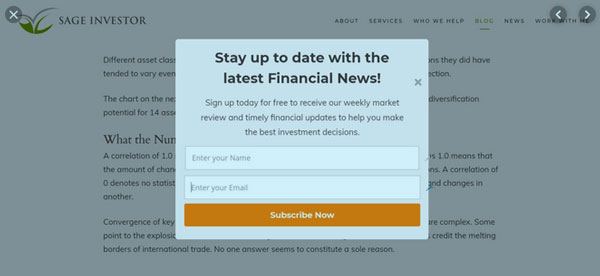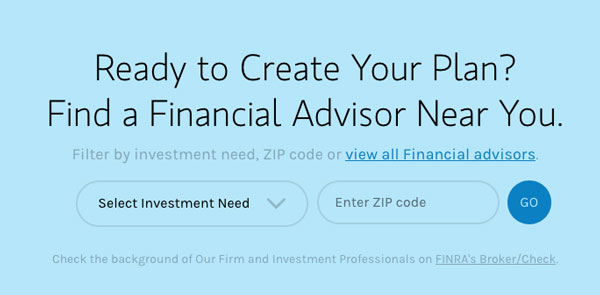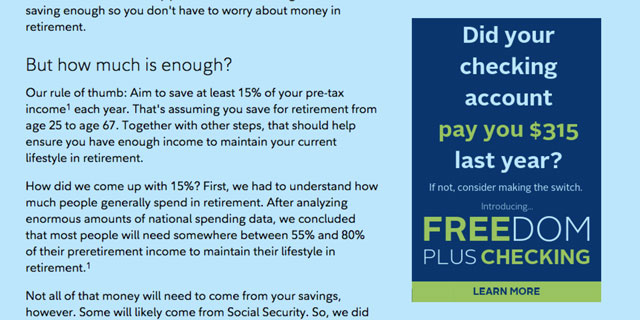When you’re looking for a new computer or air conditioning repair service, is your first impulse to call up a salesperson to ask questions? Probably not. With the internet providing website upon website of peer reviews, informational articles and recommendations, salespeople no longer bear the onus of educating potential buyers.
Customers searching for financial information are in exactly the same mindframe. They’re ready and willing to do research on their own — they just need the right resources. In fact, most customers make it over halfway through the sales journey by themselves, meaning they’re making decisions about your business, services, and products long before your sales team steps in. If your financial organization wants to influence clients, you need to make yourself part of the conversation early.
Most Americans desperately need your help understanding complex finance topics. The general public lacks solid financial literacy. Even those with a working knowledge of finance—or first-hand experience with financial products—lack solid comprehension of their options. Managing investments, loans, savings, and credit cards takes a nuanced understanding of how different financial products work at a granular level.
Yet Americans interface with complicated financial topics all the time. Every day, they open 401ks, take out mortgages and loans, and juggle debts — with very little working knowledge of those concepts. These facts may not bode well for our country’s financial well-being, but they are a good argument for providing long form financial content. Longer pieces — those that come in at 1,850 words or more — provide the space to explain more complex subjects, even if you need to spend part of the article playing catch-up for your readers.
Long form content not only provides the practical function of educating your customers, but also can boost your organization’s reputation. Providing quality, helpful financial information — for free — serves as a goodwill gesture, helping position your business as “one of the good guys.” It’s a bit like sending a handwritten card instead of a text: customers can see that you made an extra effort, and it counts. That distinction matters, especially considering that only 30% of Americans say they trust the banking industry.
Furthermore, long form content tends to perform better on the internet. It is easier for users to discover, since search engines now show preference for quality, in-depth pieces. More specifically, longer articles tend to rate better on marketing performance metrics such as search rankings, traffic, leads and conversions. In other words, long pieces are seen, shared and linked to more often than shorter pieces, and they tend to generate more new customers.
Those facts have not gone unnoticed by financial services providers. In fact, many organizations now create and share sterling, in-depth financial education content. For instance, here are a few that are nailing the long form concept:
- Fidelity Investments: How much should I save for retirement?
- Credit Karma: Credit Karma Guide to Establishing Credit in the U.S.
- Wells Fargo: Small business guide: Managing your operations to have positive cash flow
While the three examples above come from large companies, even the smallest financial firm can afford to write long form educational content on their own or hire a firm like ours to do so.
Table of Contents
ToggleLong Form Content and the Changing Role of Sales and Marketing
Now let’s talk about how long form content can help your sales team. The role of the salesperson is currently in a state of flux: research indicates that consumers now make it through 57% of the sales process on their own,
without ever speaking to a sales representative. We won’t go as far as some have to say this spells “the death of the salesman,” but it does mean that your digital presence now bears the onus of selling your products and services. The good news is that it frees up time for your sales team to focus on quality, bottom-of-the funnel leads.
Ironically, this strategy also takes some of the burden off your marketing and content creation team as well. Long form articles and ebooks provide the perfect opportunity to repackage existing content, such as a series of shorter blog posts or previous case studies. Conversely, longer pieces typically focus on evergreen topics and can be broken down into infographics, short blog articles and social media posts, or used as downloads in email marketing and Google ad campaigns. One hand washes the other.
How Long Form Content Benefits Financial Institutions
Besides offering an opportunity to expand on more complicated topics, long form content offers some concrete benefits for financial institutions — or anyone hoping to market to consumers.
Along with high search engine rankings and social media performance, long form content also offers more abstract benefits for your organization’s reputation, your relationship with customers, and consumer perception of your brand.
Our keyword research proves that people are searching on Google for answers to their financial questions. They will either find the answers to their questions on your site or on your competitors. If your website requires or only encourages people to call you or schedule a consultation before you are willing to share some of your expertise, you are likely losing out on the opportunity to do so by failing to provide answers to their questions early in the sales cycle—in other words, before they are ready to speak with a sales rep. Instead of cautiously guarding your expertise, with long form content, you’re offering it freely, and that generosity can go a long way.
More specifically, here’s what long form content can do for your financial services organization:
- Long Form Establishes Authority. It’s one thing to say you’re an expert and quite another to provide a demonstration. Long form pieces provide a forum for “show, don’t tell” concepts. Outstanding, unique long form content, such as survey findings, industry case studies and in-depth how-to articles, position your business as a financial authority and cast your organization as a thought leader within the finance industry
- Long Form Builds Trust. If people don’t trust your business, they won’t buy your products and services. The reverse is also true, however; in one survey, over 40% of respondents said they had used products from trusted financial services providers in the last year. Consumers report that a company’s reputation is one of the most important metrics they use when choosing financial services; according to Demand Gen’s 2017 Content Preferences Survey Report, 78 percent of leads have used a case study to research information before a purchase, 77 percent have used white papers, and 67 percent have read ebooks. Long form content, which provides a free, high-quality resource for customers in need, goes a long way to burnish your business’s reputation and drive purchasing decisions.
- Long Form Is Easier to Find in Search. Longer articles tend to perform better on search engines than similar content with a lower word count. One study, for instance, found that articles appearing on the front page of Google search results average nearly 1,900 words — a far cry from the clipped, 400-word blog posts of old.
- Long Form Reaches More Customers. The publishing platform Medium performed a massive analysis of the content published on the site and discovered that posts averaging a seven-minute read time tend to garner the most page views. Using the average reading speed of 265 words per minute, that translates to roughly 1,855 words. In another study, the marketing automation platform Hubspot found that pages with a word count of between 2,250 to 2,500 perform much better in organic search, generating over twice the amount of organic traffic as posts with fewer than 1,750 words.
- Long Form Is More Likely to Go Viral. As you would expect, some of those page views come not from search engines, but from shares on social media and links to the content embedded in other articles — so-called backlinks. Hubspot’s research revealed similar findings on the correlation between word count and social shares — i.e., that posts above 2,500 words receive the highest volume of social shares. The SEO educational site Moz produced its own study and found that research-backed content does produce more backlinks and shares, especially when those pieces come in at over 1,000 words.
- Long Form Increases Conversions. Sharing and viewing content is one thing. Gaining new customers from that content is another. Here again, longer content reigns supreme. For instance, when website heatmap service Crazy Egg extended the length of their homepage, they increased conversions by 30 percent. SEO expert Neil Patel found the same thing on his site: the longer the content, the better the conversion rate. While it may not be true in every single case, statistically, long form is a safer bet if you want to raise your conversion rates.
Google Loves Long Form Content
In the early days of content marketing, the clipped, 300-word blog post reigned supreme. Companies were pumping out micro-articles on any topic they could think of, hoping to jimmy search engine algorithms to raise their ranking. So-called content farms sprang up in response, designed to pump out huge volumes of content, regardless of how useful it actually was to readers.
Today’s search engines are much more sophisticated, however. Google is ranking sites not just by keyword use or volume of content but by quality as well. Thanks to the Panda algorithm update, Google can seek out thin, “filler” content, making it appear lower in search results.
Google’s aim in making these changes to its algorithm is to allow users to find the most relevant, useful content. This basically consists of articles that fulfill the original promise of content marketing: a free resource for consumers designed to widen reach, drive traffic and generate leads. This preference for quality content tends to favor in-depth articles, which naturally provide more detailed, nuanced coverage of a topic.
That’s not to say that longer is always better. A short, concise piece will almost always perform better than one stuffed with unnecessary words. However, study after study confirms that a good long article gets more love from Google than short, simplistic pieces.
Generating Leads Through Long Form Content
Long form content can be a powerful tool for generating new business, but just posting that content on your website isn’t enough. You also need to seal the deal — that is, get potential customers, or leads, to get in touch.
As UX pro Steve Krug advises in his landmark book Don’t Make Me Think, good website pages and content let visitors accomplish a task as easily as possible. Therefore, if your aim is to get users to give you their contact information, you need to make it easy for them. One important thing to remember no matter which tool you use is that people will only give you as much information as they see value in your content. So if you want to ask them to fill out a bunch of fields to download your information you better ensure the content is extremely valuable.
There are several tools you can use to do so.
Pop-Up Forms

These forms appear when a user exhibits certain behavior, such as staying on a particular page for a defined period of time, scrolling or navigating away from the page. Anyone who’s used the web before has probably seen one of these: they appear in the center of the screen and block the content until the user takes an action, either by following the call to action (CTA) or dismissing the popup. One of the most popular pop-up formats is the lightbox pop-up, where content on the page appears in shadow in the background behind the CTA.
These types of pop-up forms can be very effective at driving visitors to take specific, actionable steps. As a whole, these campaigns can be generated and tracked effectively through a marketing automation tool like HubSpot.
However, you’ll be most likely to successfully engage leads if you tailor pop-ups to be relevant to the content at hand. For instance, you can direct readers to download a related ebook, subscribe to a newsletter or request a demo rather than simply connecting with a sales rep.
Embedded Forms

Contact forms embedded at the beginning, end or middle of content are another way to collect information from potential leads. Forms have the benefit of being slightly less intrusive than pop-ups, particularly when placed at the end of the content. At the same time, they are easier to ignore.
A marketing automation tool can help you build these forms, but you’ll need to make a decision about where to place them on the page. Embedded forms work particularly well where it makes sense to gather more information from prospects — for instance, if you are asking them to sign up for a newsletter or requesting their information in exchange for an ebook download.
Sidebar Offers

Sidebars are another way to handle the CTA without distracting from the content on the page. Sidebars function a lot like forms and pop-ups, although they typically include graphic elements — such as contrasting colors — that make them stand out on the page.
One benefit of sidebars is that you can program them to slide in at a particular point in your content, attracting attention at just the right time. You can also place sidebars “above the fold” — in other words, on the part of the page that users will see when they first arrive on the page, before they have to scroll down. This is associated with more conversions, since many readers won’t make it all the way to the end of the page.
On the other hand, sidebars are not mobile responsive and should not be your one-and-only CTA strategy. Additionally, there is some evidence that sidebar designs distract from content, leading to fewer conversions than a simple CTA placed at the end of an article.
CTA Images

CTA images, particularly buttons, are an ever-popular way of generating conversions. These buttons feature unique, action-oriented text and direct users to a landing page where they can take their next steps. These can be placed repeatedly throughout a page without distracting too much from the original content.
Your Content Is Only as Good as Your Marketing Strategy
Like any other strategy, long form content campaigns are not a certain path to marketing success. Strong content cannot fulfill its purpose — that is, reaching readers and generating leads — unless you help it along the way.
Promotional tools like strong pay-per-click and landing page campaigns, social media posts, email marketing and other efforts are the wind beneath long form content’s wings. These mediums help put eyes on the content your team has worked so hard to produce, expanding your business reach and ultimately winning more prospects.
Along the same lines, it’s no good to have stellar content if your website isn’t up to snuff. Well-organized, intuitively designed sites add authority to your words and ultimately influence how consumers perceive your company.
If that seems like a tall order — particularly while you’re busy managing the day-to-day work of providing quality financial services to clients — don’t worry. A professional marketing agency, like Neon Ambition, can help you create long form content and launch campaigns to promote it, as well as help you set up the tools to track conversions into your CRM. Connect with us today to learn more about how we’ve helped financial services providers like you win more business with quality content and well-heeled marketing campaigns. You’re just one short click away from winning the long form content game.








